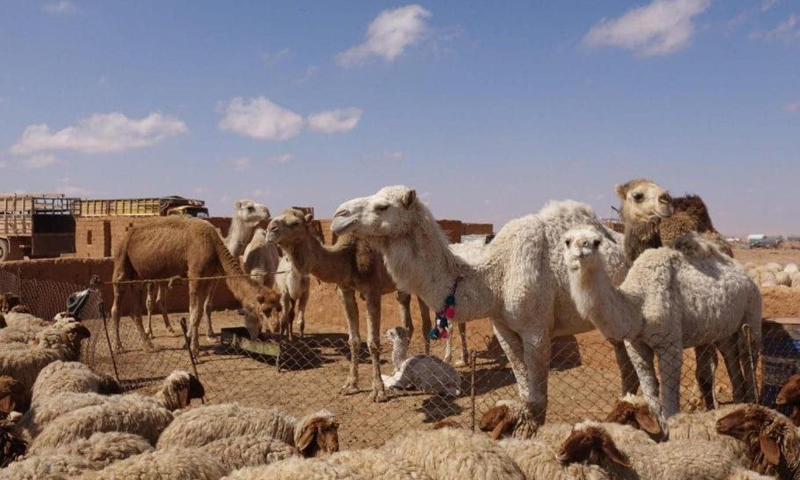



Al-Hasakah – Majd al-Salem
For decades, the family of Safouk Hussein has been keen on raising camels in the northeastern governorate of al-Hasakah as a habit they cherish despite the many difficulties encountered in camels’ care.
Hussein, 60, feels proud because he has preserved the camels he owned for all these years in the southern countryside of Qamishli city, especially in the drought conditions and security risks that the region is currently experiencing.
Hussein told Enab Baladi about his ten camels and how the number is increasing and decreasing from time to time and about his struggle to secure fodder and pasture for it with difficulty securing a market for its products or selling it.
But what lessened the hardships is that his goal in raising camels is not commercial as much as it is a kind of preservation of the original Arab customs in camel breeding.
Breeding camels before 2011 was “very profitable,” as they produce milk almost all year round, where each camel gives about three kilograms of milk per day, in addition to its meat and dander, according to Hussein.
This was confirmed by several livestock breeders from the Qamishli countryside in a survey conducted by Enab Baladi in the area.
They said that the number of camels in the northeastern governorate has greatly decreased in the past ten years.
The number of camel breeders also decreased due to their inability to secure the requirements of their breeding and the security risks that made it difficult to graze them in pastures where annual thistles, “ramtha” plants, and other shrubs grow, on which camels feed.
The interruption of camel trade routes in the region was one of the main reasons for the decline in interest in herding, especially in other governorates that were considered as a major market for selling camels, such as Hama and Damascus and its countryside.
The camels are usually located in areas far from the gathering of villages, near the Badia (al-Hamad) desert in eastern Syria.
Obaid Abdulbaqi, 49, who works in the trade of Arab camels and “purebred” horses, warned that camel breeding in al-Hasakah is threatened with extinction due to the lack of support from institutions specialized in this field.
Abdulbaqi, who is based in the southern countryside of Qamishli, estimated the number of camels in the area at about 1000 camels, and the most famous types of camels breeds found in the region are the Shamiya-Wadha camels or the white, and the al-Malha (the reddish-brown), and the yellow camels, dubbed in Arabic as (al-Safra).
Their prices range between 500,0000 and 2 million Syrian pounds (between 140 and 550 US dollars), and the price of camels varies according to their age, sex, and color, as the demand for them increases during the sacrifice period in the Muslim Eid al-Adha holiday.
According to Abdulbaqi, the movement of buying and selling camels is very weak in general as a result of the high cost of fodder and striking drought.
The price of a ton of hay reached 1 million Syrian pounds (290 US dollars), and a ton of barley was about 2 million pounds (550 US dollars).
According to several breeders contacted by Enab Baladi, the exact number of camels is not known at the present time in al-Hasakah governorate as no official statistical process has been carried out in the eastern region since 201.
The Autonomous Administration of North and East Syria (AANES), which controls the region since 2017, has done a survey of the camels’ number, but it is still not finished yet.
Osama Hammoud, director of animal production at the Syrian Ministry of Agriculture, said in early December 2021 that the number of camels reached about 40,000 in all Syrian regions, and these are unfixed numbers because it depends on the growth rates of the herds.
International relief organizations warned in August 2021 that millions of people in Syria and Iraq are at risk of losing access to water resources amid fears of a disaster due to drought, high temperatures, record low water levels, and lack of rainfall.
The “Autonomous Administration” estimated last April the rate of decline of the Euphrates River by more than 5 meters from the standard level of the river, and by more than 4 meters in the Tishreen Dam lake, and in the Euphrates Dam (al-Assad) lake, the rate of decline is more than 3 meters.
if you think the article contain wrong information or you have additional details Send Correction